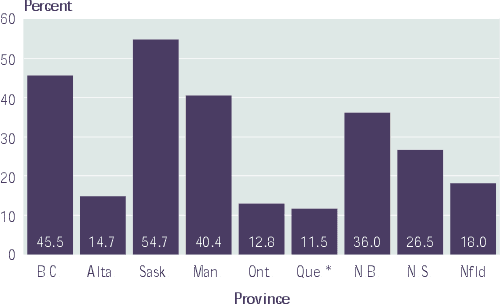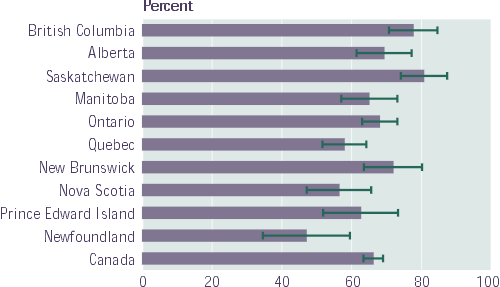Common menu bar links
Institutional links
Diseases & Conditions
Health & Safety
Research & Statistics
Agency Information
Search Box
E-mail this page
Participation in Screening Programs
The success of screening programs in reducing mortality from breast cancer in the population depends directly on achieving high attendance rates and a high frequency of screening at regular intervals. Organized breast cancer screening programs in Canada have grown substantially over the last decade from a single program screening 9,371 women in 1989 to nine programs screening a total of 470,876 women in 1998 (Table 3). Despite these gains, provincial participation rates of women aged 50 to 69 in 1997 and 1998 ranged from 11.5% to 54.7%, well below the 70% participation rate targeted by screening programs in other countries. On a more positive note, programs in Manitoba and New Brunswick, which were established in 1995, have already reached a participation rate of close to 40% (Figure 4).
Another source of data on screening participation is the self-reported information from the 1998/99 National Population Health Survey (NPHS), which reflects mammography delivered within and outside of organized programs. Among Canadian women aged 50 to 69, approximately 66.3% (95% CI 63.5-69.1) reported receiving a screening or diagnostic mammogram in the previous 2 years. Provincial estimates ranged from 47.1% to 80.8%. The two provinces with the highest participation in organized programs, Saskatchewan and British Columbia, also had the highest overall self-reported levels (Figure 5).
|
Organized breast screening programs have grown substantially over the last decade; however, provincial participation rates of women aged 50 to 69 in 1997 and 1998 ranged from 11.5% to 54.7%, well below the 70% target. |
|
Table 3 |
||||||||||
|
Program |
1989 |
1990 |
1991 |
1992 |
1993 |
1994 |
1995 |
1996 |
1997 |
1998 |
|
B.C. |
9,371 |
22,985 |
55,884 |
83,969 |
104,380 |
123,879 |
150,248 |
166,756 |
173,923 |
189,987 |
|
Alta. |
- |
616 |
5,873 |
15,442 |
16,148 |
15,373 |
14,182 |
14,696 |
23,376 |
18,896 |
|
Sask. |
- |
6,355 |
14,305 |
15,778 |
26,057 |
25,540 |
29,603 |
28,891 |
33,913 |
34,044 |
|
Man. |
- |
- |
- |
- |
- |
- |
2,671 |
13,598 |
19,165 |
23,463 |
|
Ont. |
- |
591 |
15,404 |
40,335 |
45,591 |
55,494 |
58,316 |
67,763 |
80,178 |
98,591 |
|
Que. |
- |
- |
- |
- |
- |
- |
- |
- |
- |
49,700 |
|
N.B.* |
- |
- |
- |
- |
- |
- |
5,827 |
18,709 |
18,161 |
25,220 |
|
N.S. |
- |
- |
1,877 |
4,354 |
4,891 |
8,461 |
12,491 |
15,547 |
19,477 |
25,454 |
|
Nfld. |
- |
- |
- |
- |
- |
- |
- |
3,120 |
4,690 |
5,521 |
|
Canada |
9,371 |
30,547 |
93,343 |
159,878 |
197,067 |
228,747 |
273,338 |
329,080 |
372,883 |
470,876 |
|
* Data for the New Brunswick program are incomplete and therefore do not comprehensively reflect program activity. |
||||||||||
|
Figure 4 |
 |
|
* The 1998 population estimate was halved for Quebec to approximate
participation rates at least |
Mirroring the increased growth in screening through organized programs, mammography obtained in the fee-for-service sector has also risen over the past decade. As of 1994, an estimated 80% of mammography obtained in the fee-for-service sector was done for screening purposes15. This development is of concern, because such screening mammography is delivered in an ad hoc fashion without targeting or recalling women who are most likely to benefit from mammography screening. Organized screening programs can ensure quality control elements of the screening process and monitor interim indicators that the program is on track towards achieving a breast cancer mortality reduction in the population. However, not all screening programs have the resources to reach all women in the target population adequately. Expansion of organized breast cancer screening programs and allocation of additional resources for the recruitment of target aged women would reduce barriers, such as waiting lists or lack of access to organized screening.
|
Figure 5 |
 |
|
Data Source: 1998/99 NPHS Health Canada Share File |
[Previous] [Table of Contents] [Next]
